IRELAND AT EXPO 2025
Ireland and Japan are entering a new era of collaboration – in political cooperation and partnership, trade and investment, cultural exchange, and people to people links.

FOREWORD
Ireland Japan 2025
●
2025 will be an exciting year for Ireland in Japan, one of our closest and long-standing partners. Reflecting the depth and range of this important relationship, the Government is committed to strengthening Ireland’s political, economic and cultural connections with Japan. The opening of Ireland House Tokyo and our presence at World Expo Osaka, will represent the most ambitious investment in this valued relationship since the opening of our Embassy in Tokyo in 1973.
Ireland House Tokyo, the new home for our Embassy and the State Agencies, and participation in Expo Osaka will transform Ireland’s presence in Japan, delivering on a commitment in the Joint Statement, which I signed as Taoiseach with Prime Minister Kishida in July 2022, to take relations and exchanges between our two countries to a new, higher level.
Our relationship with Japan is built on strong foundations of shared values of freedom, democracy, human rights and the rule of law. Japan is our second largest trading partner in the Asia Pacific region, with annual two-way trade of approximately €23 billion. As a like-minded partner with whom we have natural synergies, there is very significant potential for increased trade in goods and services, and for high value investment into Ireland. There is also a joint commitment to deepen the natural a nity and the close and friendly relations between our two peoples. We enjoy dynamic connections through education, research, sport, culture and youth exchange, which we are determined to nurture and strengthen in the years ahead.
Team Ireland in Japan will benefit immediately from the networking potential of our programme at Expo 2025, which runs from April to October. Relationships established during those six months will be consolidated for the long-term through the opening of Ireland House in Tokyo. Our intention, set out in the Joint Statement, is to deepen our long-term, durable bonds for the benefit of our two island nations, but for the benefit of the world. Both countries want to see a strong and dynamic relationship based on close political, economic and people-to-people ties, but effective partnership in multilateral and regional bodies.
Japan and Ireland share a deep respect for tradition and nature, for makers and artists, for musicians and writers, storytellers and theatre-makers. Through the cultural programmes of Ireland House and Expo 2025 we will explore, develop and breathe new life into cultural and creative bonds, bringing our peoples closer than ever before.
Ireland House gives us a state of the art, offcial presence in Japan and a space to showcase, celebrate and grow this dynamic relationship. Expo 2025 enables us to engage intensively for six months with the people of Japan, to meet, to explore new ideas and to share cultural experiences – and most importantly of all, to work together for the benefit of humanity.
Together, these initiatives will leave a lasting footprint for Ireland in Japan. They deliver on commitments in the Japan-Ireland Joint Statement and the Government’s Asia Pacific Strategy.
2025 will represent a step change in Ireland’s relations with Japan, a partnership that we value greatly and wish to grow to its full potential.
Micheál Martin
Tánaiste and Minister for Foreign Affairs


Global Ireland
●
The Global Ireland Strategy – a multi-annual, whole-of-government initiative to double the scope and impact of Ireland’s global engagement by 2025 – places considerable emphasis on building awareness of Ireland’s characteristics and values, recognising that a strong image of Ireland abroad is important for achieving our foreign policy objectives as well as promoting trade and investment, attracting students, tourists and talent to Ireland, and encouraging cultural and scientific exchanges.
The 2023 Global Ireland Asia Pacific Strategy commits us to implementing the multi-faceted, cross-Government Ireland-Japan Joint Leaders’ Statement signed by the Taoiseach and Prime Minister Kishida in July 2022 with the aim of ‘bringing relations to a new, elevated level’. The Statement prioritises political, economic and cultural cooperation through the delivery of a new Ireland House in Tokyo which shows the strength of Ireland’s commitment to expanded relations and exchanges between the two countries. It also undertakes to bring a strong, collaborative ‘Team Ireland approach’ to Ireland’s participation at Expo Osaka in 2025.
Ireland’s participation in World Expos is a core part of the Global Ireland programme. The concept of World Expos originates in the French tradition of national exhibitions. World Expos (previously known as World Fairs) are governed by the Paris Convention on International Exhibitions of 1928, and the Bureau International Des Expositions (BIE) established by the Convention. World Expos offer important meeting opportunities for the global community, providing a platform to connect businesses, civil society, governments, creators and thought leaders, as well as millions of visitors from the host country and around the world.
As a small, open society that has undergone rapid social and economic transformation, we are constantly seeking new opportunities to expand our global relationships and increase our influence in the world. As a quinquennial gathering of the nations of the world over a period of six months, Expo 2025 presents a unique set of opportunities. With a projected 28 million visitors and intense media and social media coverage, Expo 2025 will enable us to increase awareness of and affinity with Ireland, both in Japan and across the wider Asia Pacific region.
Ireland House Tokyo
●
As a small country with a highly globalised economy, Ireland’s engagement with the wider world is important for ensuring the long term prosperity of our people. Japan, as a like-minded and stable democracy with a modern high-tech economy, is one of Ireland’s closest partners in Asia. Both countries marked 60 years of warm bilateral relations in 2017. The Japan-Ireland Joint Statement, signed in Tokyo by the Taoiseach and Prime Minister Kishida in July 2022, set out a wide range of areas for increased cooperation.
Ireland House, overlooking a park in central Tokyo, is scheduled to open in 2025. The new home for Ireland’s Embassy and the offices of the State Agencies, It is a tangible sign of strengthening our relations and will be a major milestone marking Ireland’s commitment to deepening our strategic partnership with Japan.
Ireland House is an established model for the effective promotion of Ireland’s diplomatic, cultural, trade and economic goals, and citizen services in host nations. There are currently Ireland Houses in 20 different cities across the globe, soon to be 24, including Abu Dhabi, Shanghai and most recently, Stockholm.
The Ireland House Tokyo project was run as an international design competition led by the Royal Institute of the Architects of Ireland (RIAI) and is the largest single capital investment abroad by the Government of Ireland since the foundation of the State.
The completed building will serve as a 3,000 square metre flagship example of the Ireland House concept in which business and community events will be hosted as well as showcasing the vibrancy of Irish arts and culture. It will house the Embassy, offices for State agencies, an official residence, and a multi-purpose state of the art performance, exhibition and conference space for the promotion of Irish business, educational links, arts and culture and community exchanges.
Ireland House will have the capacity to meet the needs of Team Ireland, both now and into the foreseeable future, as Ireland continues to strengthen its existing warm bilateral relations with Japan.
Together with the Embassy, Ireland’s trade and investment promotion agencies – IDA Ireland, Enterprise Ireland, Bord Bía and Tourism Ireland – will leverage the opportunities presented by the opening of Ireland House Tokyo to promote Ireland as a unique country to visit, a world-class supplier of goods and services, an internationally renowned investment partner and a globally connected research and innovation base.
The opening of Ireland House Tokyo provides an unprecedented platform for Ireland by putting in place a permanent infrastructure which will enable us to derive maximum benefit from shared programming initiatives across Tokyo and Osaka in 2025 and to optimise the connections and relationships developed at both.
Ireland House Tokyo. Images: Henry J Lyons Architects
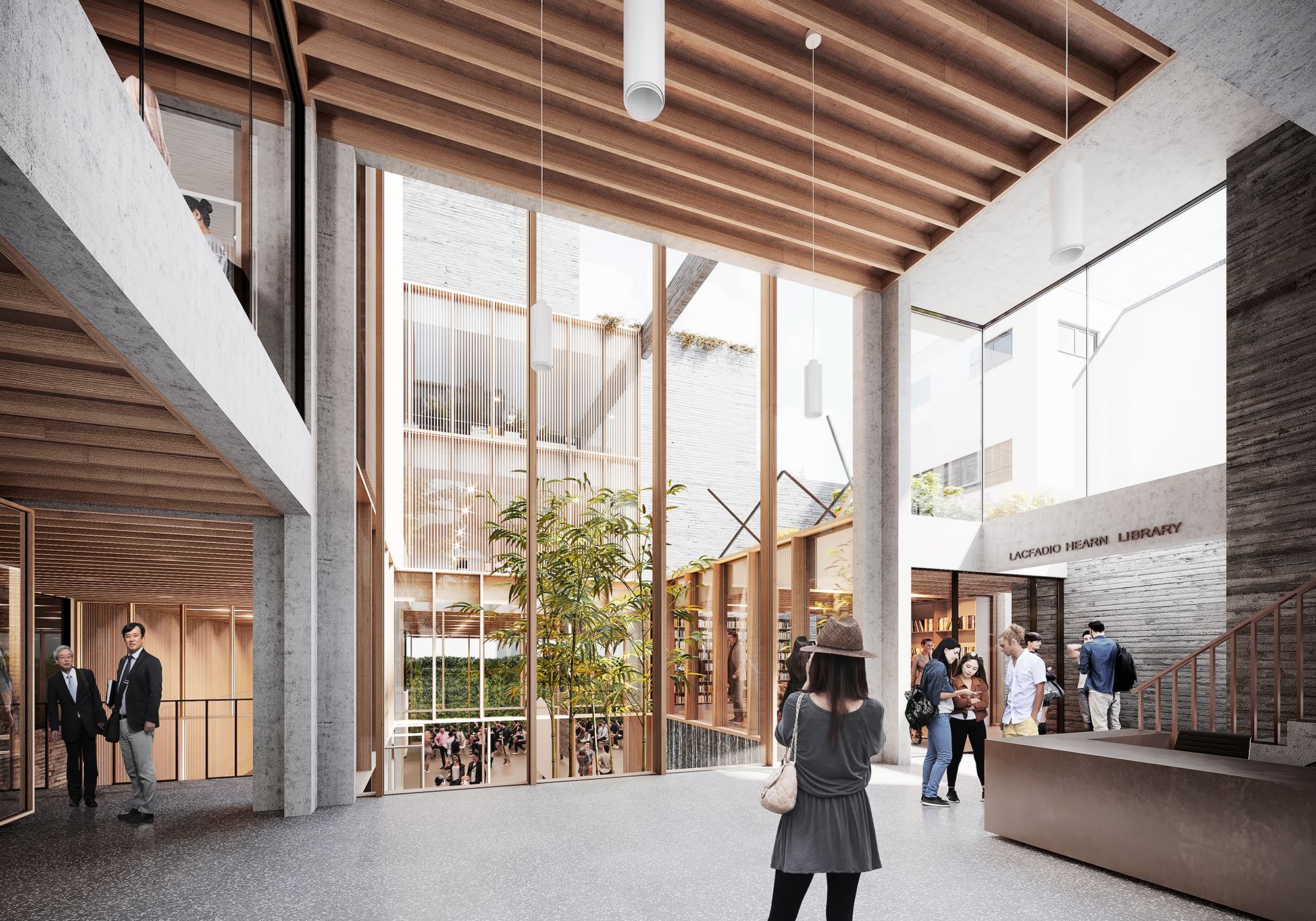
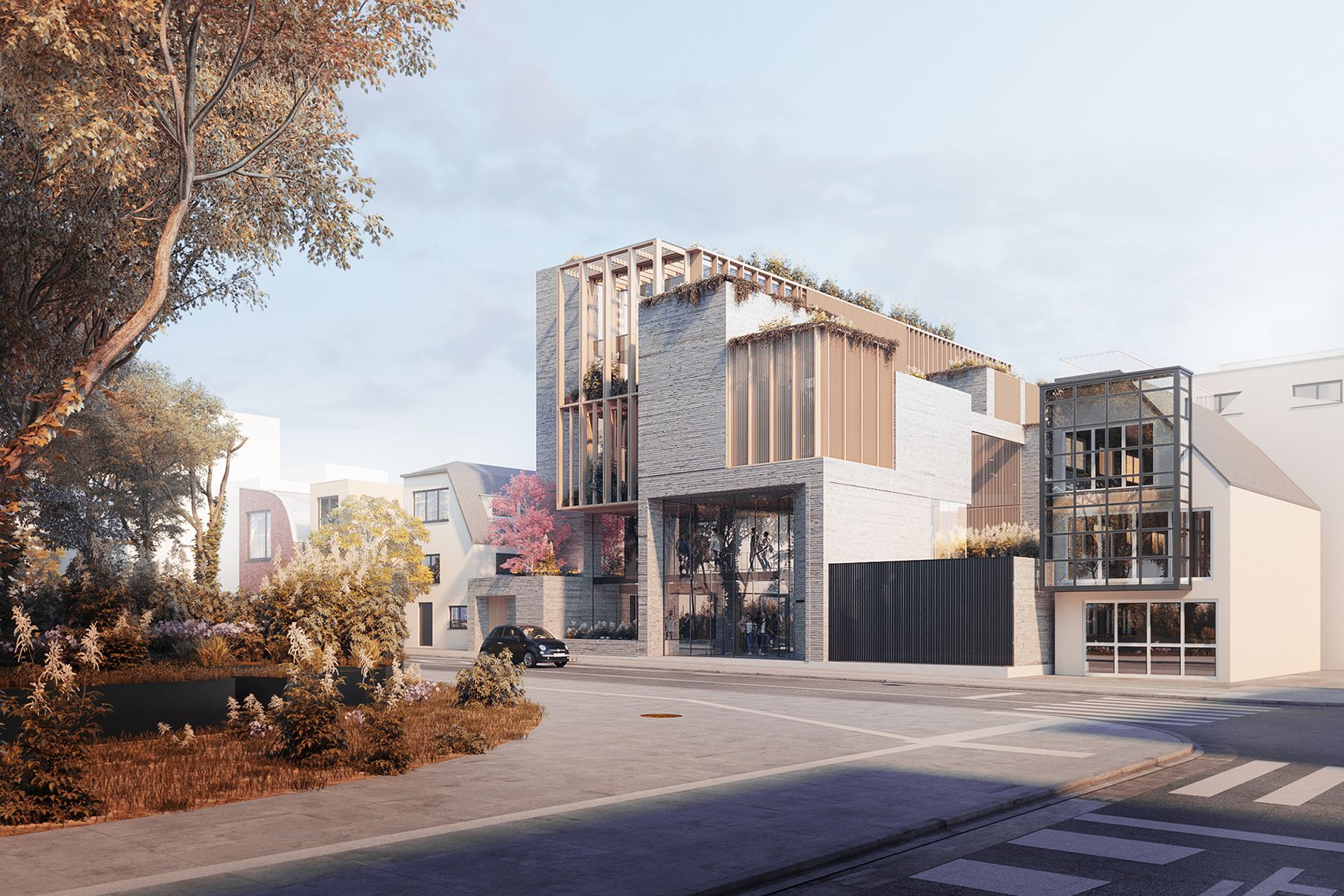


Expo 2025
Osaka, Kansai, Japan
●
World Expo 2025 will take place in Osaka, Japan from 13 April to 13 October on a 155-hectare site on Yumeshima, an artificial island in Osaka Bay. An expected 160 countries and international organisations will participate.
The overarching host-country theme for Expo 2025 is: Designing Future Society for Our Lives. Japan’s expressed aim is to promote international cooperation in the creation of a sustainable society in the midst of issues that include growing economic inequality, wars and other forms of violence, as well as scientific and technological developments such as artificial intelligence and biotechnology that are likely to have a profound impact on humankind.
The overarching host-country theme for Expo 2025 is: Designing Future Society for Our Lives. Japan’s expressed aim is to promote international cooperation in the creation of a sustainable society in the midst of issues that include growing economic inequality, wars and other forms of violence, as well as scientific and technological developments such as artificial intelligence and biotechnology that are likely to have a profound impact on humankind.
The overarching Osaka theme is supported by three subthemes:
Connecting Lives Enriching society through culture and community
Empowering Lives Leading happy and prosperous lives
Saving Lives Addressing challenges that threaten people and life on Earth
Japan’s theme is also expressed as a society that achieves the UN Sustainable Development Goals and, for Japan itself, their national strategy, Society 5.0.
In 2015, Ireland and Japan played central and complementary roles in the UN process to agree the Sustainable Development Goals. The negotiations culminated in an agreement on the 2030 Agenda for Sustainable Development which was formally adopted in September 2015.
Society 5.0 represents the era of artificial intelligence and data-driven decision-making, the internet-of-things, widespread robotics, and massive displacement and replacement of skills and occupations. It is expressed as a human-centric strategy, offering the opportunity to make vast improvements in the quality of human lives.
The sub-themes provide the basis for eight theme weeks over the course of the Expo programme, culminating with ‘SDGs+Beyond’ which will focus on the overarching theme of ‘Designing Future Society for Our Lives’.
Illustration: Expo 2025 Osaka Kansai logo

IRELAND'S THEME FOR EXPO 2025
CREATIVITY
CONNECTS
PEOPLE
●
創造性は
人々をつなぐ
Ireland’s theme for Expo Osaka – Creativity Connects People – was developed with three objectives: first, that it would reflect policy as expressed in major all-of-Government initiatives such as Project Ireland 2040, Global Ireland, Creative Ireland, and Healthy Ireland; second, that it would express what are generally held to be interconnected, values-based, Irish characteristics of community, creativity and adaptability to transformative change as outlined in the Global Ireland Integrated Communications Framework; and third, that as a human-centric theme it would engage with, amplify and respond to Japan’s high level theme of ‘Designing Future Society for Our Lives’.
Our theme draws inspiration from Creative Ireland, the all-of-Government programme that seeks to ensure that everyone in our society has the opportunity to realise their full creative potential.
The Programme is built around two propositions:
That human creativity is a vital contributor to individual and societal wellbeing – The Wellbeing Proposition, and
That a creative mindset and creativity skills will be increasingly necessary in the 21st century society and economy – The Futures Proposition.
Our theme, therefore, places a strong emphasis on the nexus between human creativity, wellbeing and the role of creative imagining in shaping our future. It articulates the combined proposition that creative imagining and creative action are defining characteristics of our species that provide the shared ground for all human progress, including peacebuilding, conflict resolution and social innovation.
Creativity Connects People will be expanded for particular subject matter to include concepts of Time, Place and Culture.
IRELAND & JAPAN
ISLAND NATIONS OF THE EAST AND THE WEST
●
東西の島国
Ireland and Japan are two ancient island nations situated at the either ends of the Eurasian landmass. Despite the geographical distance, an exploration of art, literature, music, and values reveals an intricate tapestry that draws us together.
Culture and the Arts
Literature
Irish literary giants such as James Joyce and W.B. Yeats share with Japanese masters such as Haruki Murakami and Yoko Ogawa a quest to explore the human condition, dealing with identity, exile, and the conflicts between tradition and modernity. Many Japanese people are also struck by the similar sensibilities of early Irish poetry and the Japanese waka.
As a shared programming initiative for Ireland House Tokyo and Expo Osaka, Literature Ireland will publish a monthly series of six short books. These publications will feature works by some of Ireland’s finest writers in Japanese translation, spanning a range of genres and eras, and will include selections from ancient Irish sagas and Bram Stoker’s ‘Dracula’ as well as work from contemporary writers in English and Irish.
Music and Dance
Traditional Irish music finds an echo in the intricate rhythms and melodies of Japanese music. Both forms are built on storytelling, communal experiences, and the preservation of cultural heritage. The National Concert Hall will curate an eclectic programme of traditional and contemporary Irish music at the Ireland House Pavilion at Expo.
Irish music and Irish dance are enjoyed and performed by significant numbers of Japanese people who are supported by Comhaltas Ceoltóiri Éireann in Japan and Irish music circles and Irish dance schools across Japan. Through their dedication to Irish culture, this strong a nity diaspora helps to preserve our traditions and enhance Ireland’s visibility in Japan. The Ireland Pavilion at Expo 2025 will provide a platform to showcase these talented performers.
Storytelling
Japan and Ireland share a reverence for storytelling. The Japanese art of storytelling through the traditional medium of Rakugo yields up long, complicated stories – highly reminiscent of the art of the Irish Seanchaí!
Art & Craft
Japanese art and craft shares with ours a focus on natural materials and features of the landscape – trees, rocks, small animals and birds – and a similar blurring of the western distinction between ‘art’ and ‘craft’. Both cultures emphasise a deep respect for the past and an awareness of the ephemeral nature of existence, thus fostering a sense of continuity and reverence, which is visible across all art forms.
Lafcadio Hearn
Koizumi Yakumo
●
小泉 八雲
Patrick Lafcadio Hearn was born in 1850, the son of an Irish father and a Greek mother. He grew up in Ireland where he absorbed local traditions of storytelling. He later honed his skills as a writer in the United States.
Hearn came to Japan as a journalist in 1890 and found employment in Matsue, in Shimane Prefecture in Western Japan, where the Lafcadio Hearn Memorial Museum and his old residence are still prominent tourist attractions. He married Setsu Koizumi, the daughter of a samurai and assumed the name Koizumi Yakumo. It was in Japan that he wrote his most renowned works. Hearn is one of the first great Western observers of the Japanese way of life. He brought Japanese culture to the English-speaking world through non-fiction works such as Glimpses of Unfamiliar Japan (1894). He is most renowned for his ghost stories drawn from traditional Japanese folklore infused with memories of his own childhood in Ireland to create Kwaidan: Stories and Studies of Strange Things. His works are regarded as classics in Japan to this day.
The Kwaidan Exhibition Tokyo and Osaka
Kwaidan was first published in 1904. A new exhibition of the same name – Kwaidan – features the works of 40 artists, from Ireland and Japan, who have been inspired by these strange and ghostly tales. The exhibition will form part of the opening season, and the permanent art collection of Ireland House Tokyo. It will also feature in the Ireland House Pavilion at Expo 2025.
The interpretations of the Kwaidan stories are presented through a diverse collection of contemporary fine art printmaking and photography. Some of the Kwaidan tales are ancient, some local folklore, but Hearn wove them into a language that is joyously translated into visual form.
Each individual artwork in the exhibition expresses the beauty, fear and inevitability of death. These eerie and macabre stories are interpreted through a variety of highly skilled print media. In addition to honouring Hearn’s literature, these artworks deepen the cultural bonds between Japan and Ireland in a medium that blurs the boundaries of art and craft.
The Kwaidan stories and exhibition will be further illuminated by a Halloween Festival as part of our Expo programme.
From KWAIDAN - Encounters with Lafcadio Hearn, Stephen Lawlor O-Jochu (Mujina). Etching, 2023.
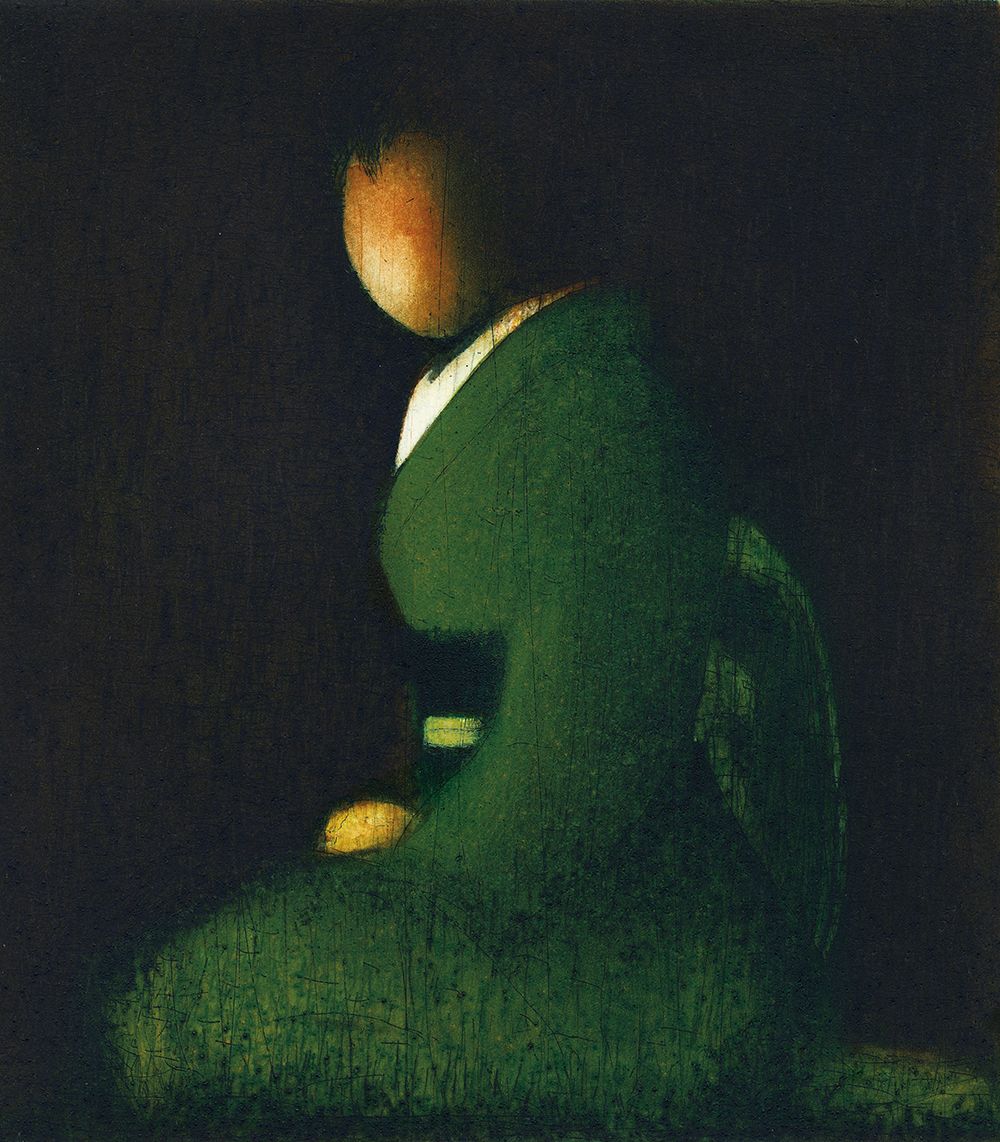
The Journey of Weather-Exposed Bones
●
Nozarashi-Kikō
The Journey of Weather-Exposed Bones is a non-narrative, experimental film-poem inspired by a new and complete translation of Basho, the seminal Japanese poet and father of the Haiku. The film is a collaboration between acclaimed film-artist Alan Gilsenan and Irish poet, translator and Japanese scholar Professor Andrew Fitzsimons of Tokyo’s Gakushuin University. It is – in equal parts – a cinematic act of psycho-geography, a meditation on the devastating impact of climate change and a quasi ‘road-movie’ through contemporary Japan following the remarkable journeys of Basho in the decade leading up to his death in 1694.
The Journey of Weather-Exposed Bones, funded by the Arts Council and the Department of Foreign Affairs, will be screened both in Ireland House Tokyo and at Expo in the course of 2025.
From KWAIDAN - Encounters with Lafcadio Hearn, Eimear Jean McCormack, Horai, Screenprint

Making In — A Creative Partner for Ireland Japan 2025
●
Making In is a not-for-profit foundation conceived and developed by the Joseph Walsh Studio. It is an advocate for both the value and values of traditional craft in contemporary living and is the outcome of a long collaboration between makers, artists and thinkers.
Making In hosts an annual (early September) gathering of makers from multiple disciplines and nations who come together at the Joseph Walsh Studio in Fartha, near Kinsale in Co. Cork for a two-day series of conversations that celebrate making as a way of thinking, exploring, expressing and imagining. The conversations are interspersed with sensory experiences – visual, auditory and tactile – of making.
Making In is a strategic partner for both Ireland House Tokyo and Ireland at Expo 2025. Moderated by historian and author Glenn Adamson, the theme for Making In 2024, Circle, will bring a focus to the cyclical and consequential aspects of making, across craft, art, design, architecture, fashion, gastronomy and performance.
Since its beginnings in 2017, Making In has welcomed many speakers and participants from Japan, including sculptors Kan Yasuda and Satoru Ozaki, Takahiro Yagi, Kaikadō and designer Shuji Nakagawa. In 2024, participants will include architect Shigeru Ban, Nakamura Shikan VIII, Kabuki Theatre and Hiroyuki Tsujii, the custodian of the Karasaki Pine Tree.
Making In resonates strongly with Ireland’s Expo theme, connecting creative voices from around the world to share stories of making with a diverse international audience. A series of documentary films, made by renowned filmmaker Pat Collins, capturing the conversations, collaborations and energy of Making In, will feature both in Ireland House Tokyo and the programme at Expo.
O'Donnell + Twomey, Passage House, Fartha Co. Cork. Photo: Andrew Bradley
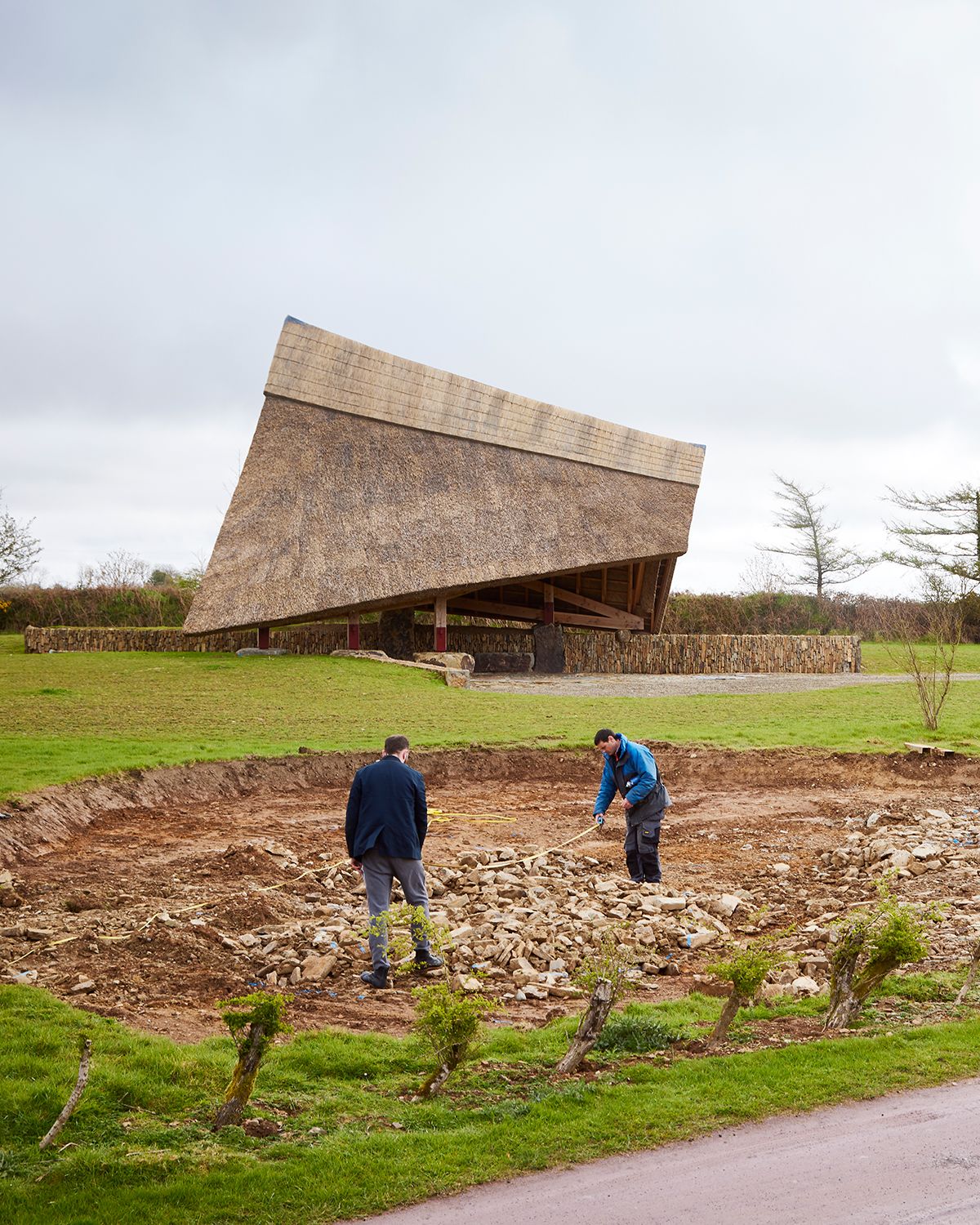
RINN
輪
●
Rinn is an exhibition conceived as an Ireland-Japan dialogue on making, place and time, specially created for the opening cultural programme of Ireland House Tokyo. Rinn will also be reflected at Expo 2025, through imagery and related exhibition objects. Rinn will return to Ireland later in 2025 at the Glucksman Gallery in University College Cork.
Inspired by Making In and the connections that have developed between makers from Japan and Ireland, Rinn is jointly curated by Joseph Walsh of Joseph Walsh Studio and Wahei Aoyama of A Lighthouse Called KANATA Gallery. It will present contemporary objects of art, craft and architecture in pairings from Ireland and Japan, alongside historical pieces, art works and making tools. The themes and ideas explored through the makers’ work will be contextualised in an accompanying publication with essays by historians, scholars, authors, poets and curators, creating a new cultural canvas for Ireland-Japan relationships.
Osamu Yokoyama. Photo courtesy of A Lighthouse called Kanata
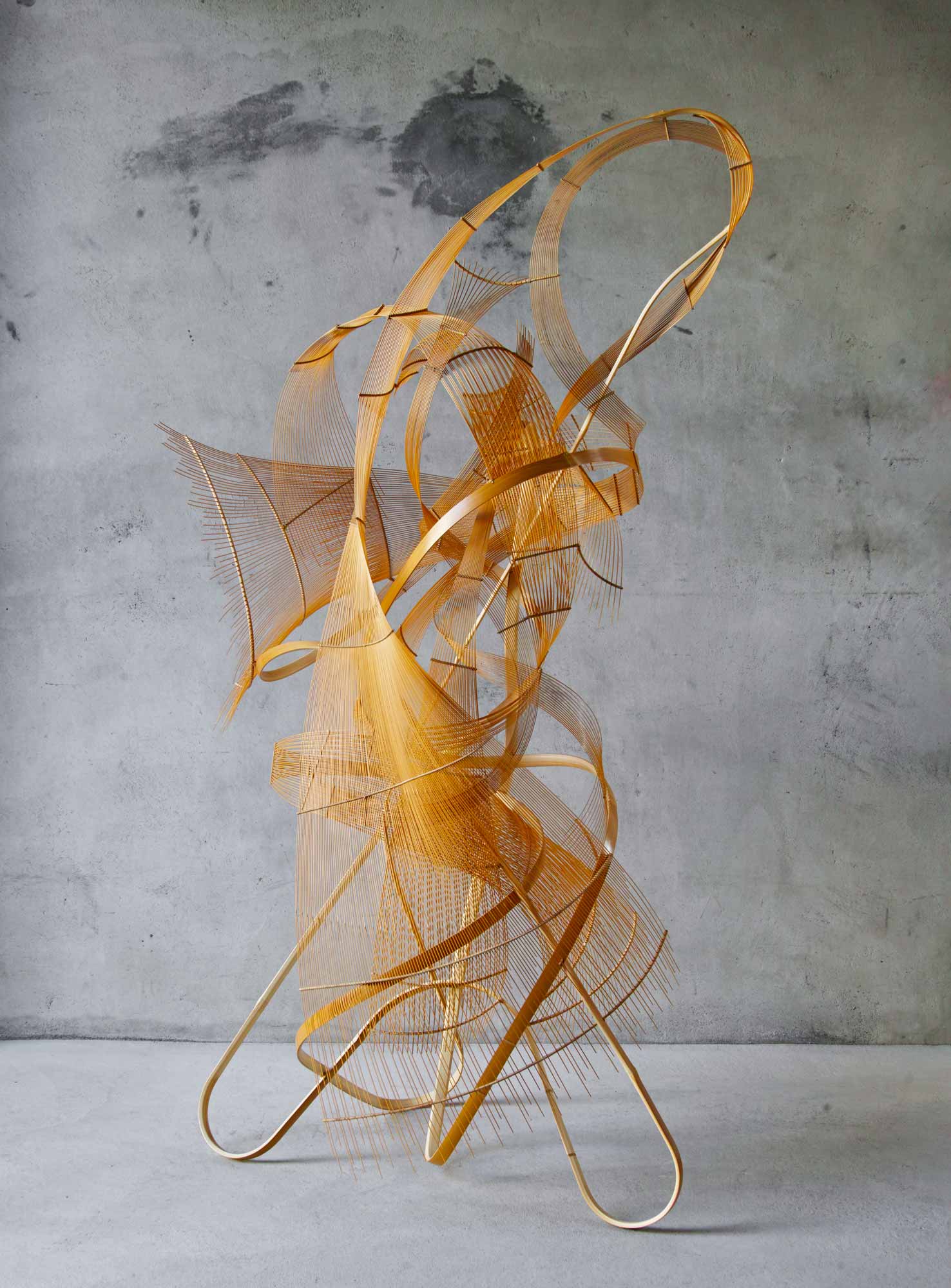
EXPO 2025
THE IRELAND
HOUSE PAVILION
●
アイルランド ハウス
パビリオン
Ireland’s pavilion is located beside the main entrance to the east of the Expo site and adjacent to The Grand Roof, an elevated, landscaped walkway that forms a ring around the entire Expo site.
The pavilion’s prominent position is an immediate advantage: it will be one of the first to be seen by visitors from ground level at the east entrance (the main arrival point), visible also from the 12m high level of the Grand Roof and from the Square of Light, a public plaza immediately to the south of the pavilion. An outdoor performance space is positioned at the south of the site, enabling music and performance to act as a beacon for passers-by.
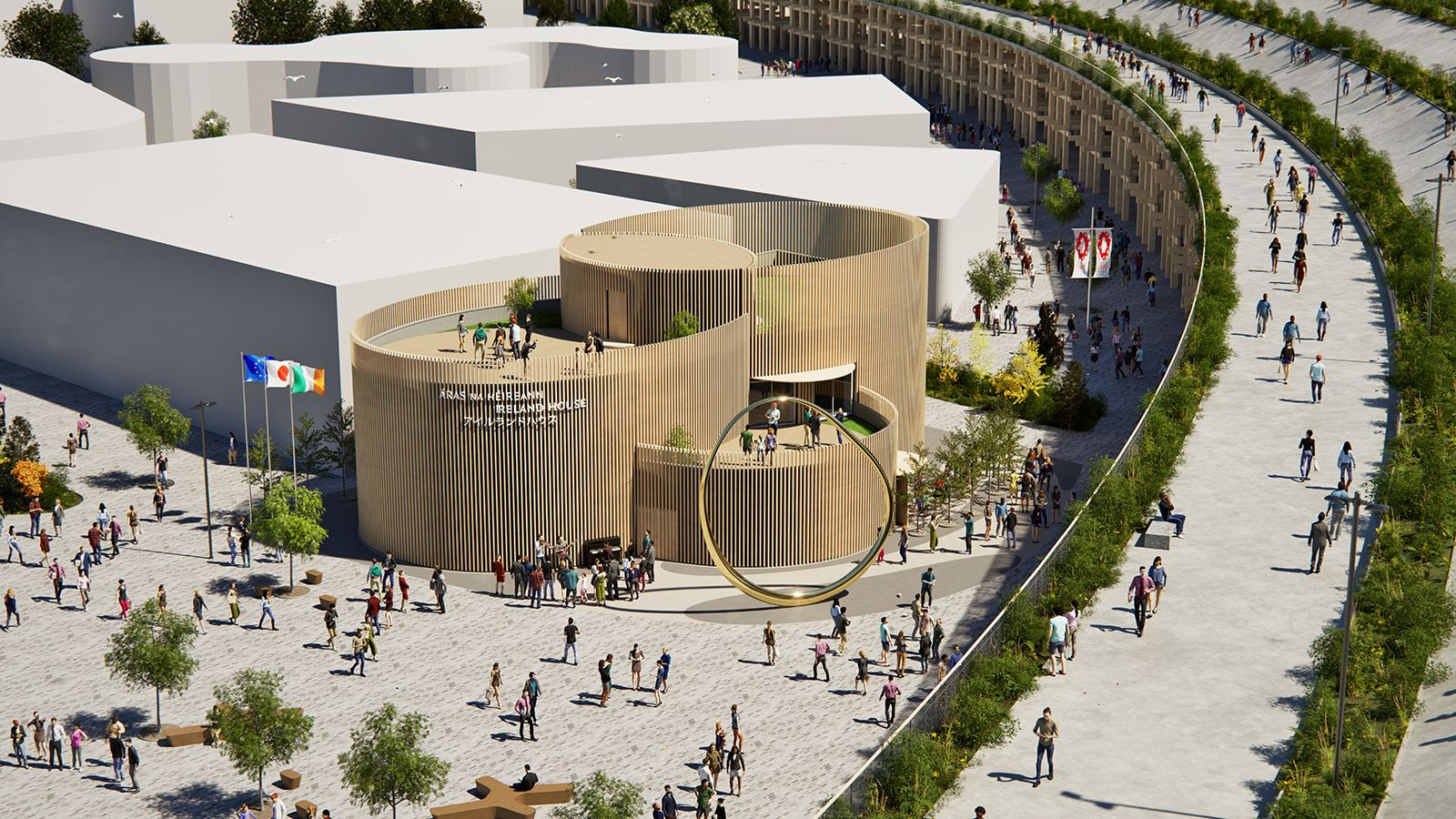
PAVILION DESIGN
●
パビリオンデザイン
The Ireland House pavilion, measuring approximately 752 sq.m, will have three discrete areas at ground (public visitor) level: the entrance hall, the first exhibition space, and the principal exhibition and performance space. All three will be linked as areas of visitor experience. These three areas take the form of elliptical elements of varying heights which intersect to represent an abstracted triple knot in three dimensions. The triple knot, or triskele, is an ancient motif which has appeared in Irish art and craft since Neolithic times.
The Ireland Pavilion is designed to be:
Contextual
The interlacing curved forms physically echo the Grand Roof and sit in harmony with it.
Nodal
The site is a place of convergence at the start of a route and the Pavilion acts as a ‘gateway’ for visitors to the entire Expo site.
Identifiable
The ‘abstracted triple knot’ shape is distinctive and carries an identifiable cultural reference.
Social
The incorporation of roof terraces at different levels creates points of interest that can be seen from beyond the site, revealing expansive views for visitors.
Ecological
The design responds to its environment – the timber façade uses a sustainable resource to provide solar shading and shelter. Timber as a construction material is common to both Irish and Japanese craft and construction.
A harmonious relationship between built and natural environment is key to the pavilion’s design. Sustainability was a crucial principle, from the inception of the design to the detailing of the construction materials and the environmental systems. The structural frame with an external envelope of vertical timber louvres has been designed to allow ease of dismantling and the recycling and re-use of materials.
The building uses and showcases sustainable Irish timber throughout, sourced by Coillte, Ireland’s state-owned commercial forestry organisation, from a single forest. Internally, dark stained timber evokes the richness of ancient Irish bog oak. The external timber louvres, sawn from Irish Douglas Fir, create depth and texture on the curved walls, accentuating the intersecting forms and creating shadows to animate the façade as the sun moves across the sky.
The extensive use of timber evokes a connection between Irish and Japanese craft and will create an immediate visual relationship with the curved timber structure of the Grand Roof.
THE VISITOR EXPERIENCE
●
訪問者の体験
The Ireland House pavilion design will bring visitors on a journey through the three ellipses of the pavilion which are being curated by the National Museum of Ireland.
The first ellipse contextualises Ireland, geographically and as a place of creativity. The second shows geographical and cultural connections between Ireland and Japan. The third shows how creative collaboration generates understanding between peoples – in this case the peoples of Japan and Ireland but also as a universal concept – reflecting the theme Creativity Connects People.
The objective is to deliver an experience that is relevant, engaging, respectful, social, tangible and transformative – and that also:
● Conjures a creative space.
● Demonstrates a strong Team Ireland purpose and intent.
● Clearly demonstrates creative expression through a variety of art forms – sculptural, visual, audio visual, performative, music and theatre.
● Mobilises technology to enhance visitor dialogue and experience.
● Delivers a cohesive and clear overall narrative.
● Provides clear definition for Ireland at Expo through a relevant, timely, human-centric theme.
● Articulates an expanded social and cultural relationship between Ireland and Japan.
● Is visitor-centric and participative.
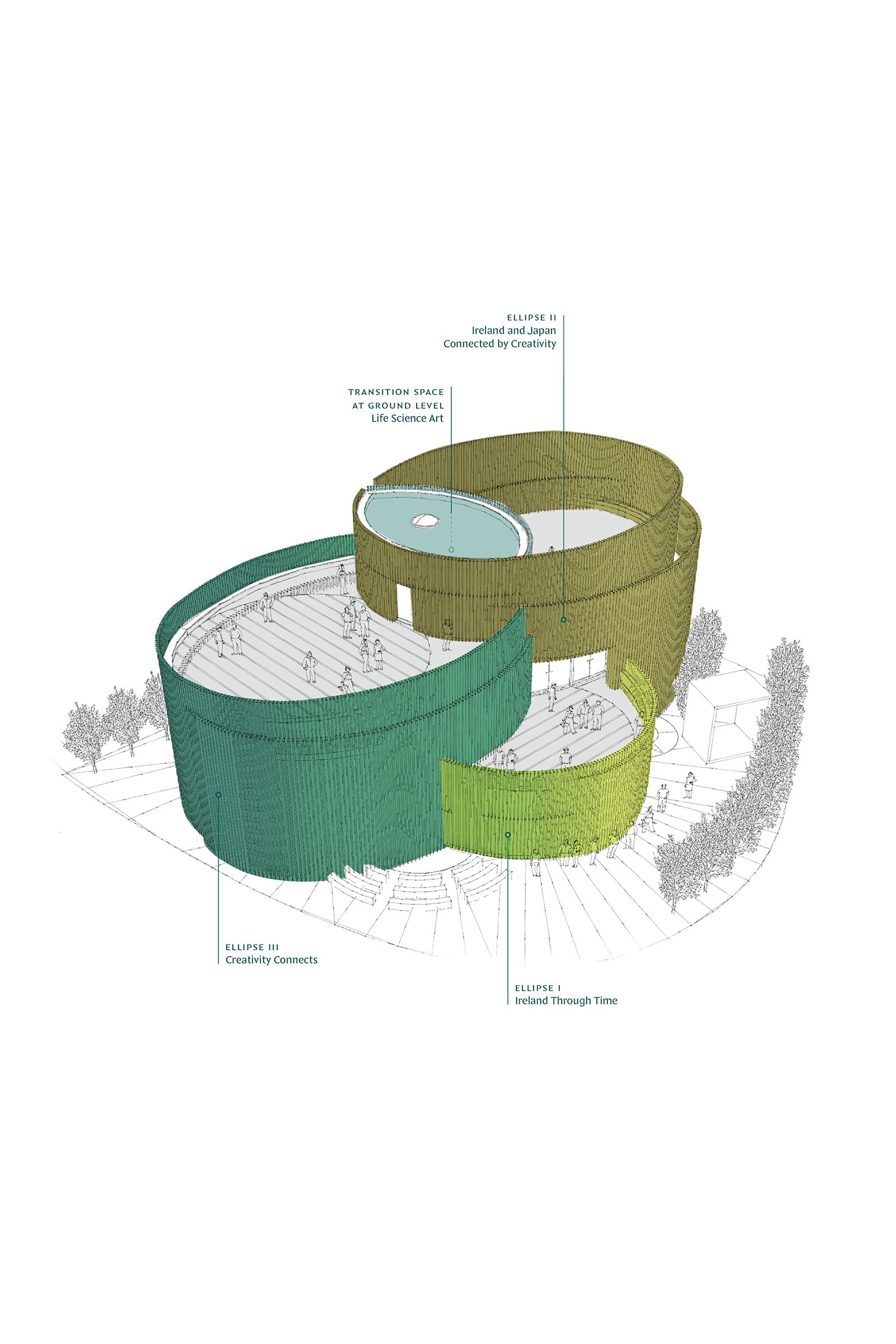
MAGNUS RINN
●
A monumental sculpture, Magnus Rinn, conceptualised by Joseph Walsh and made in collaboration with his team at his studio in Fartha, Co. Cork, will act as a tangible expression of our theme, combining beauty of form with natural materials and creative making.
Magnus Rinn is a circular form, transitioning from bronze to wood and finished in gold gilding. It symbolises the relationship between man and nature: although man made, its shape is influenced by its natural materials and the climatic and geological forces that gave them their distinctive character and substance, yielding to the passing of time and the cyclical rhythms of nature.
Magnus Rinn will sit outside the pavilion in a specially made landscape, designed by Hiroyuki Tsujii, the custodian of the Karasaki Pine Tree, in collaboration with Joseph Walsh Studio. It will act as an iconic focal point, visible from the Square of Light and the Grand Roof, and a gathering place for visitors.
Joseph Walsh Studio, Fartha, Co Cork, Making Magnus Rinn,
Photo: Andrew Bradley

ELLIPSE I
IRELAND: THROUGH TIME
アイルランド:時を超えて
Ireland: Through Time explores making in Ireland from prehistory to the present-day: a visual and sensory experience of craft from metal, wood, basket and stone work, and an evolving musical language derived from nature and extending to life-sciences, design-making and contemporary expressions of Irish music and arts. This time-based representation of Ireland will be set against landscape and the sounds of nature, with specially created film and audio content that echoes the external setting of the Magnus Rinn sculpture.
Ireland: Through Time provides the visitor with a multi-dimensional sense of Ireland, with a particular focus on the influence of ancient and traditional knowledge of craft and natural materials in a dynamic, modern culture – offering also an explanation for Ireland’s dramatic emergence in the world as a centre of technological innovation, architecture and design, natural food, and manufacturing excellence. The visitor experience will be multi-sensory including smell, audio and visual imagery.
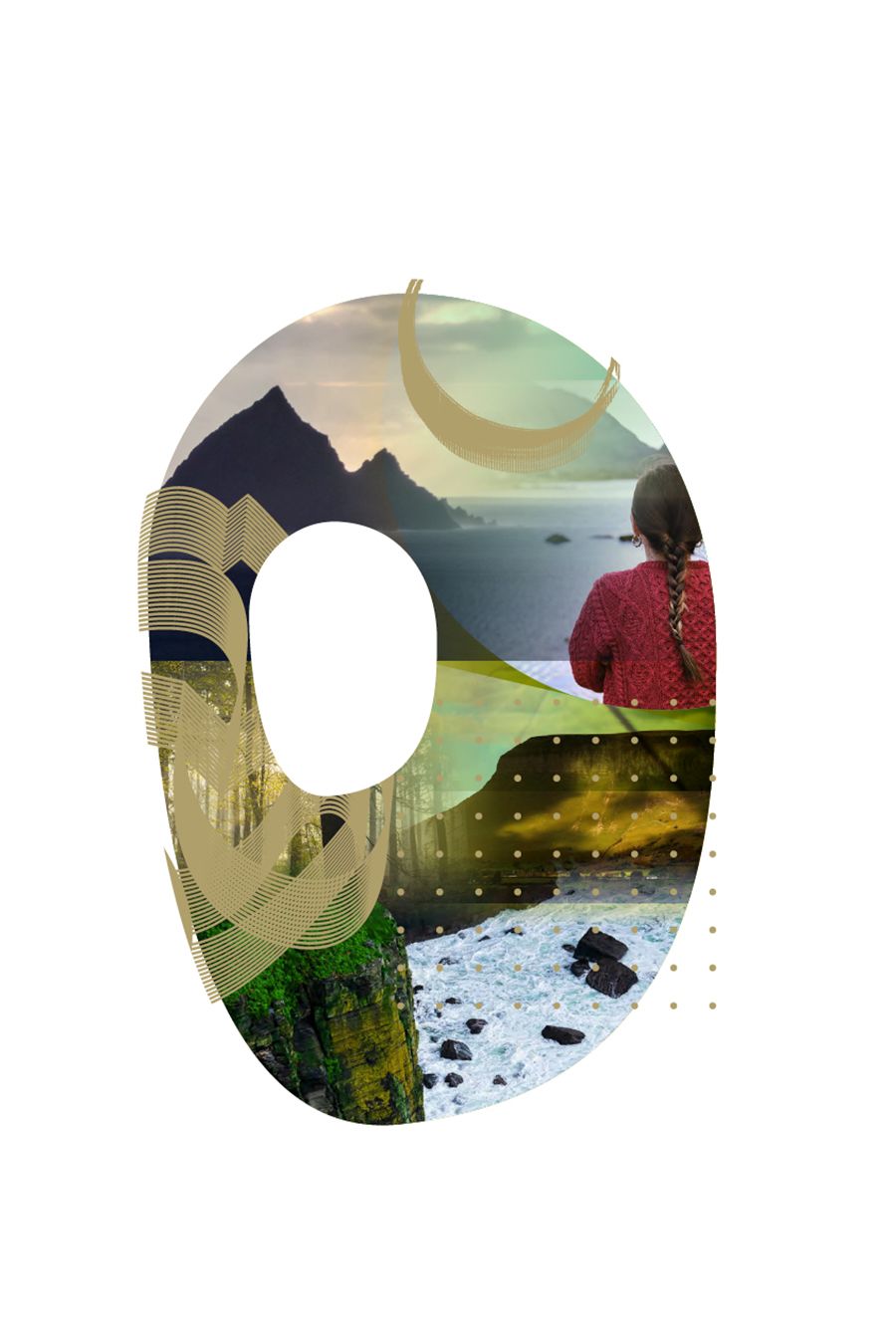

ELLIPSE II
IRELAND AND JAPAN
CONNECTED BY CREATIVITY
アイルランドと日本
創造性でつながる
In Ellipse II, visitors will explore contemporary connections between Ireland and Japan, especially in life sciences, and various craft forms. Connected by Creativity shows values, cultures and creative processes that are shared by the peoples of Japan and Ireland. In a hands-on exploration, visitors can touch and feel a variety of materials and objects from woodwork to ceramics to textiles – many made by hand, all made through creative processes. The visitor experience is characterised by imagination and curiosity, the familiar and the strange. Alongside the objects are short, looped videos illustrating the creative making processes. Connected by Creativity is being developed alongside Rinn at Ireland House Tokyo, with which it will share elements and ideas.
In Ellipse II, visitors will also reflect on Irish creativity and innovation across a broad spectrum of areas from cutting edge innovations in Life Sciences to Irish creativity in helping develop the Sustainable Development Goals.
TRANSITION SPACE
LIFE SCIENCE ART
人生 科学 美術
The transition space will be designed and lit to act as a quiet passageway from ‘Connected by Creativity’ in Ellipse II to the immersive experience of Ellipse III, evoking a sense of change and movement into the unknown. The space will contain a suspended sculptural element inspired by life sciences — exploring the interactions between art and science.
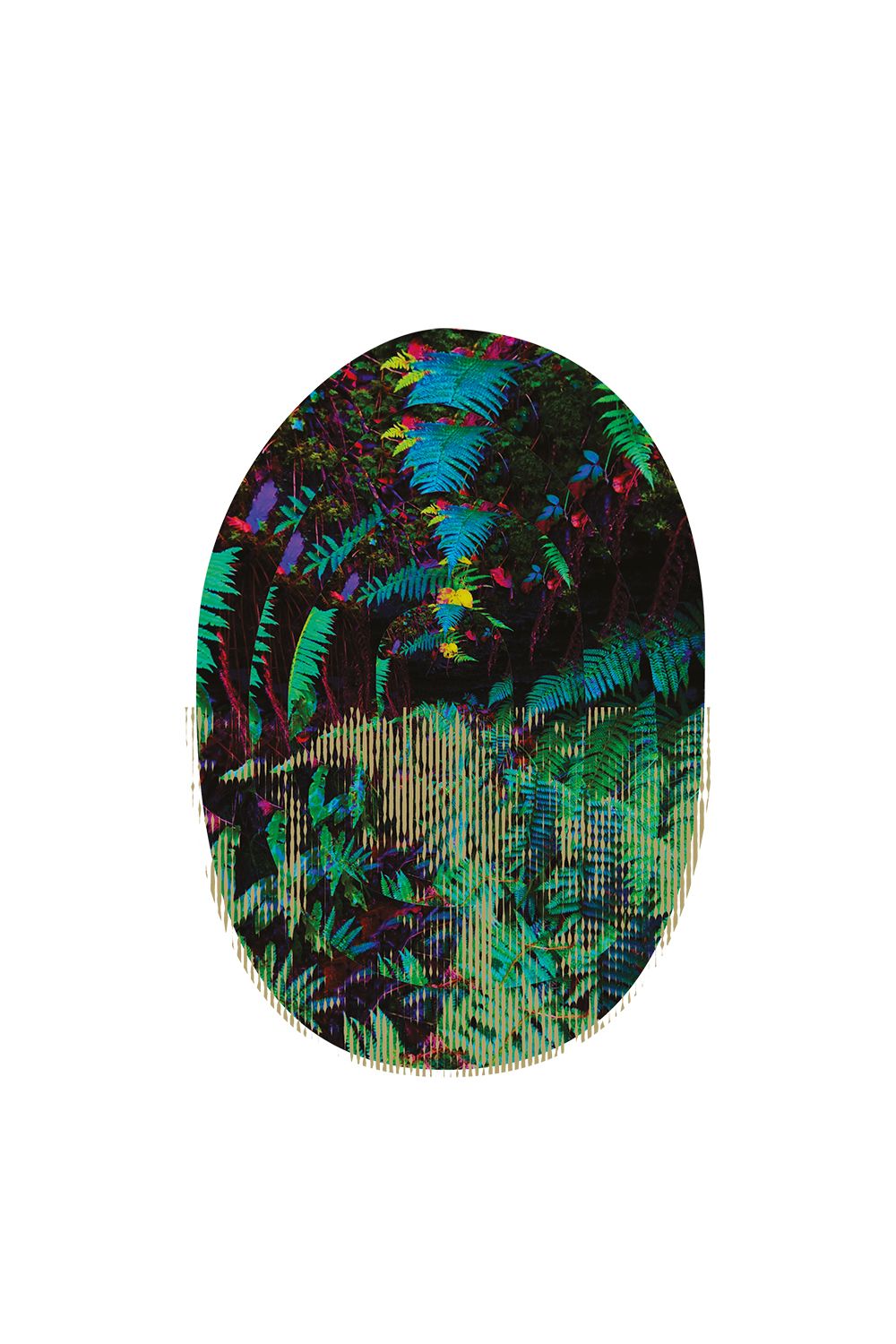

ELLIPSE III
CREATIVITY CONNECTS
創造性はつながる
Creativity Connects is a unique moment in time in which people connect with each other and with a collective experience of spontaneous music, movement and image-making, an aural, visual and tactile landscape made through guiding motifs and palettes, directed by gesture, action, touch and connection with audience members who become cocreators in that moment.
Creativity Connects invites our pavilion visitors to connect through a shared experience in which the lightest of gestures can create new and different sounds and images – a spontaneous moment of co-creation, derived from millennia of tradition and craft, informed by modern technology.
Creativity Connects will be developed by a creative team overseen by the National Museum of Ireland in collaboration with the National Concert Hall, musician and composer Caoimhín Ó Raghallaigh and filmmaker Marianne Keating, alongside theatre and other specialist designers. As the performance concludes the visitor will be invited to reconnect with the external Magnus Rinn installation and its setting.
Creativity Connects will be a single, transportable collaborative creation of makers from a variety of backgrounds and disciplines, united by an overarching focus on time, connection and music.
Illustration: Zero-G Studio
IRELAND HOUSE CONCEPT
アイルランドハウス コンセプト
The Irish Pavilion will function as an Ireland House during Expo. It will be a place of welcome for all Irish organisations in Japan and an anchor for Team Ireland and the diaspora and affinity diaspora during the six months of Expo, with a dedicated event space.
A stairwell located in a leaf-shaped internal space leads guests to an upper-level event room. From there, guests will emerge onto a private roof terrace over the entrance area, facing The Grand Roof. Moving up further through the staircase, guests will arrive at another private roof terrace, at high level, with panoramic views across the Square of Light and beyond. These spaces offer the opportunity for additional events, exhibitions and networking.
THE EXPO PLAYERS
エキスポ・プレーヤーズ
The Expo Players are Irish musicians chosen by the National Concert Hall for their musicianship and creativity, especially in re-interpreting traditional music forms. The Expo Players will perform at various locations including the social spaces of the Ireland House Pavilion, outside the Pavilion, and spontaneously in other Expo events.
With musicians rotating periodically, the Expo Players will reflect talented musicianship, connected to the past and creating new sounds and rhythms for the future, offering audiences an insight into qualities of creativity and virtuosity that are flourishing in Irish music.
The Pavilion will also showcase the deep well of talented Japanese performers of Irish music and dance, including CCÉ Japan, the Japanese branch of Comhaltas Ceoltóiri Éireann, and the many Irish music circles and dance schools across Japan.
BEYOND THE IRELAND HOUSE PAVILION
パビリオンの向こう側
Ireland will deliver a strong programme of events and activities in our pavilion but also beyond our pavilion. Successful participation in Expo 2025, with Japan as the host country and Osaka as the host city, requires high quality personal interaction and engagement involving multiple Irish participants acting under a framework which will be developed and supported by Global Ireland – in short, the ‘All of Government,’ Team Ireland approach.
The principal channels for engagement beyond the pavilion will be the Expo Theme Weeks. Our programme will also include a select number of events and projects that reflect Ireland’s outstanding creativity in the arts and sciences.
Young Scientists
●
The story of the BT Irish Young Scientist & Technology Exhibition began In 1963 when two Irish physics researchers working in the US came across the concept of ‘Science Fairs’. They decided that this type of hands-on science was something that Irish students would benefit from, by taking science outside the classroom and into the world beyond. The first competition was held in 1965 and attracted 230 entries. In recent years the number of entries has increased dramatically, now reaching more than 2000. The event attracts some 40,000 people making it one of the largest of its kind in Europe, if not the world.
Many participants go on to build celebrated careers in STEM fields. Notable past winners include Patrick Collison of Stripe and Shane Curran of Evervault. Others have also been winners of the European Union Contest for Young Scientist. 2013 winners Emer Hickey, Ciara Judge and Sophie Healy-Thow were awarded the Grand Prize from the global Google Science Fair in 2014.
Ireland will bring five projects from the 2025 Young Scientist competition to Osaka for special science and technology related events – creating connections between young Irish and Japanese scientists.
TG4 Gradam Ceoil
●
The TG4 Gradam Ceoil awards were established in 1998 to recognise and honour all who have played a prominent part in supporting, nurturing and strengthening Irish traditional music.
Gradam Ceoil shines a light on the beauty, richness, depth and dynamism of our traditional music, and gives a public platform to performers of all ages, from Ireland and across the world, who are making their mark on this ancient artform which now thrives as contemporary music. The Gradam Ceoil is awarded annually at a major live-broadcast concert.
Ireland will bring a specially created event from this annual showcase of outstanding creativity in traditional Irish music to Japanese and international audiences to mark Expo 2025.
Halloween
●
Ireland will present a specially curated, flagship Halloween Season at Expo 2025. Although Halloween is a major festival in Japan, the Irish origins of Halloween and the Bram Stoker connection are largely unknown.
The origins of Halloween can be found in the mists of pagan Ireland more than 2,000 years ago, a time when the ancient festival of Samhain was celebrated to mark the beginning of winter. It was believed, according to legend, that at Halloween the veil between our world and the ‘Otherworld’ was at its thinnest, allowing spirits and demons to easily pass between the two. Ireland can therefore be rightfully called the ‘Home’ of Halloween.
The Bram Stoker Festival celebrates the legacy of a beloved and iconic Irish writer and is now firmly established as one of Dublin’s premier arts festivals. The festival draws inspiration from Bram Stoker, his life and work. It celebrates the Gothic, the supernatural, the ‘after-dark’ and the Victorian.
Macnas is an internationally acclaimed, award winning spectacle theatre company from Galway, Ireland. Macnas productions include parades, theatre shows, installations, film and performance art.
Bram Stoker will be central to Ireland’s Halloween programme for Expo. Inspiration will also be drawn from Fáilte Ireland initiatives such as the Púca festival, Samhain Night processions, and ‘Home of Halloween’.
The Halloween Season at Expo will be created in partnership with Dublin City Council, the Bram Stoker Festival, Macnas and Fáilte Ireland.


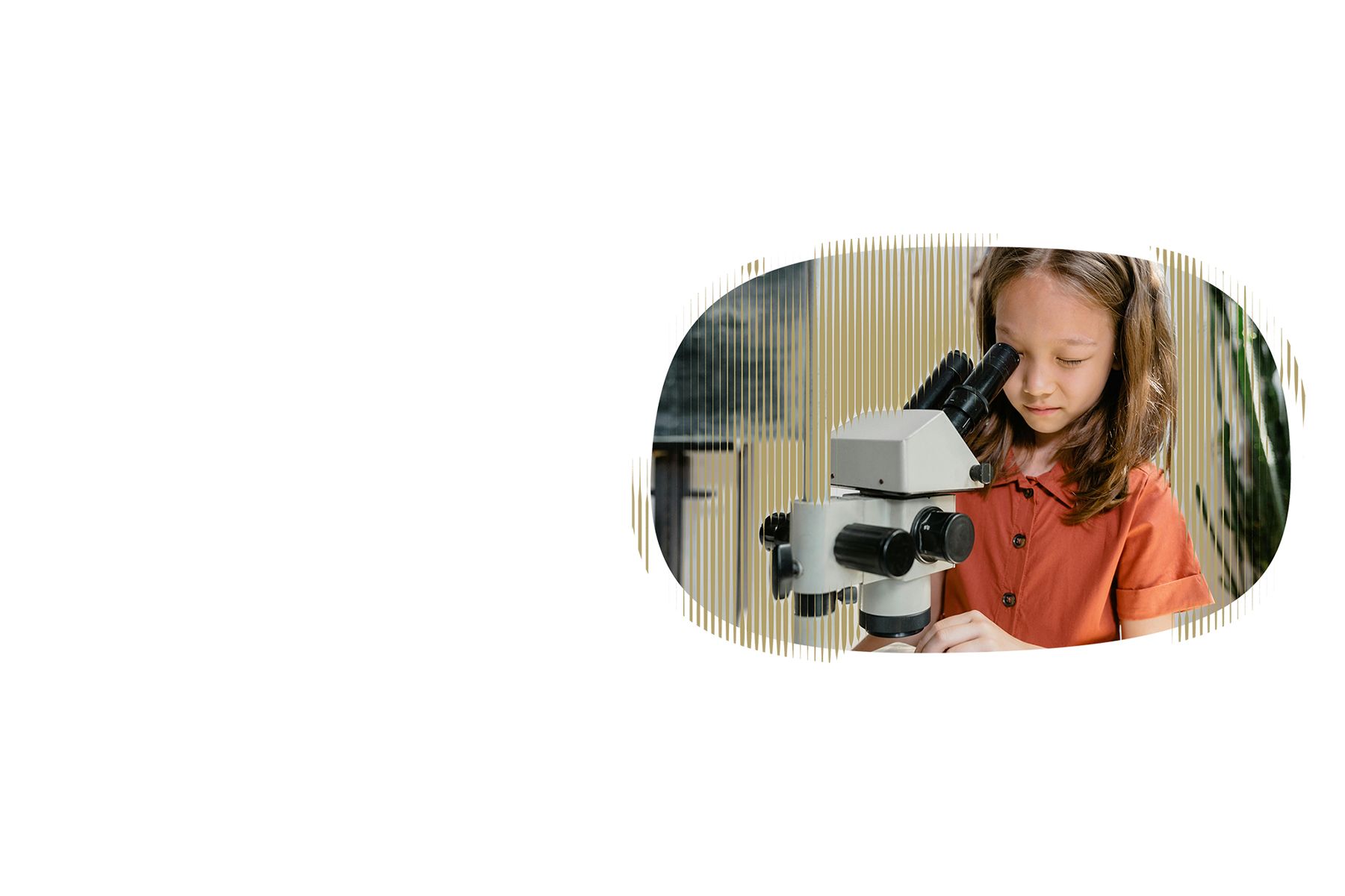
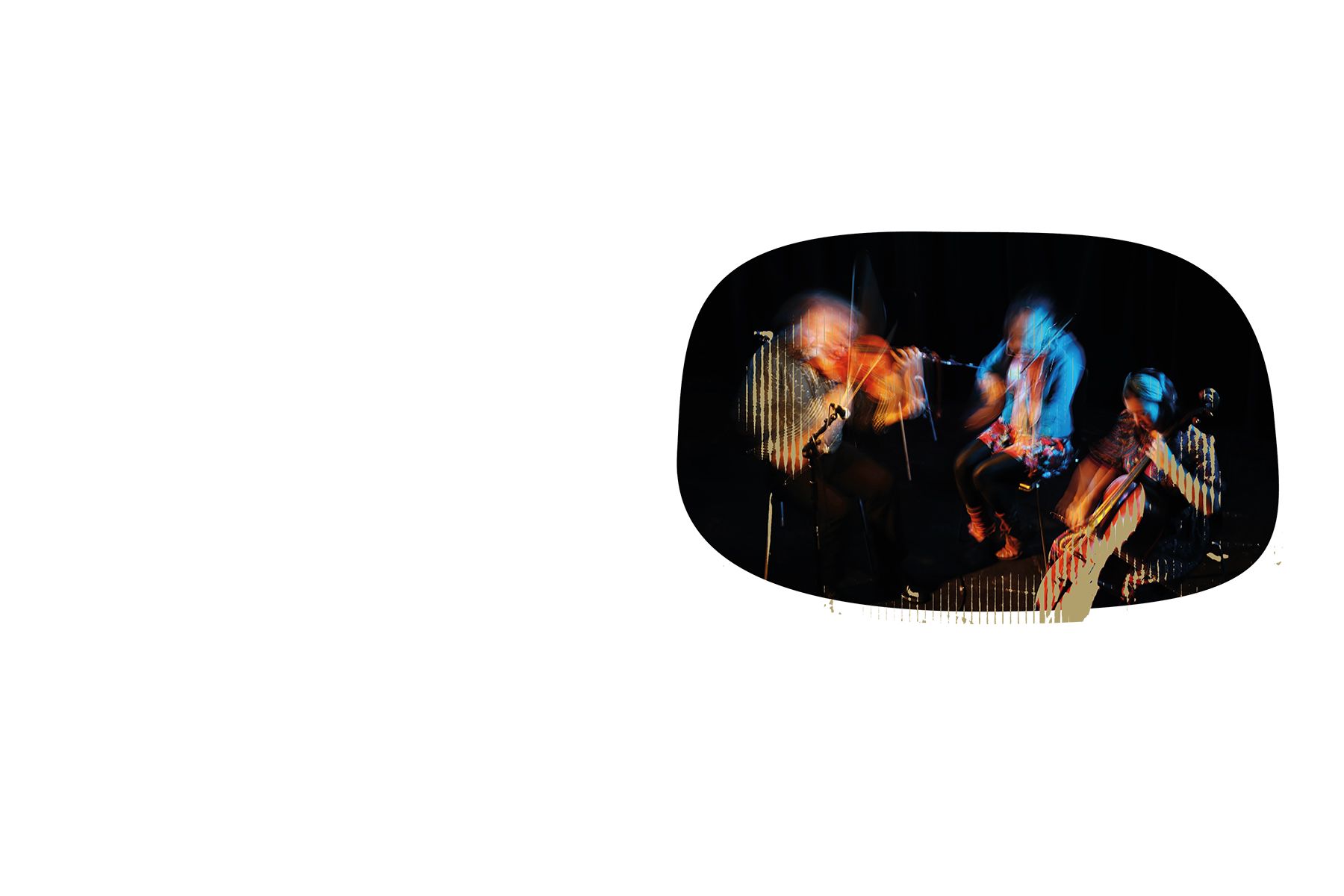
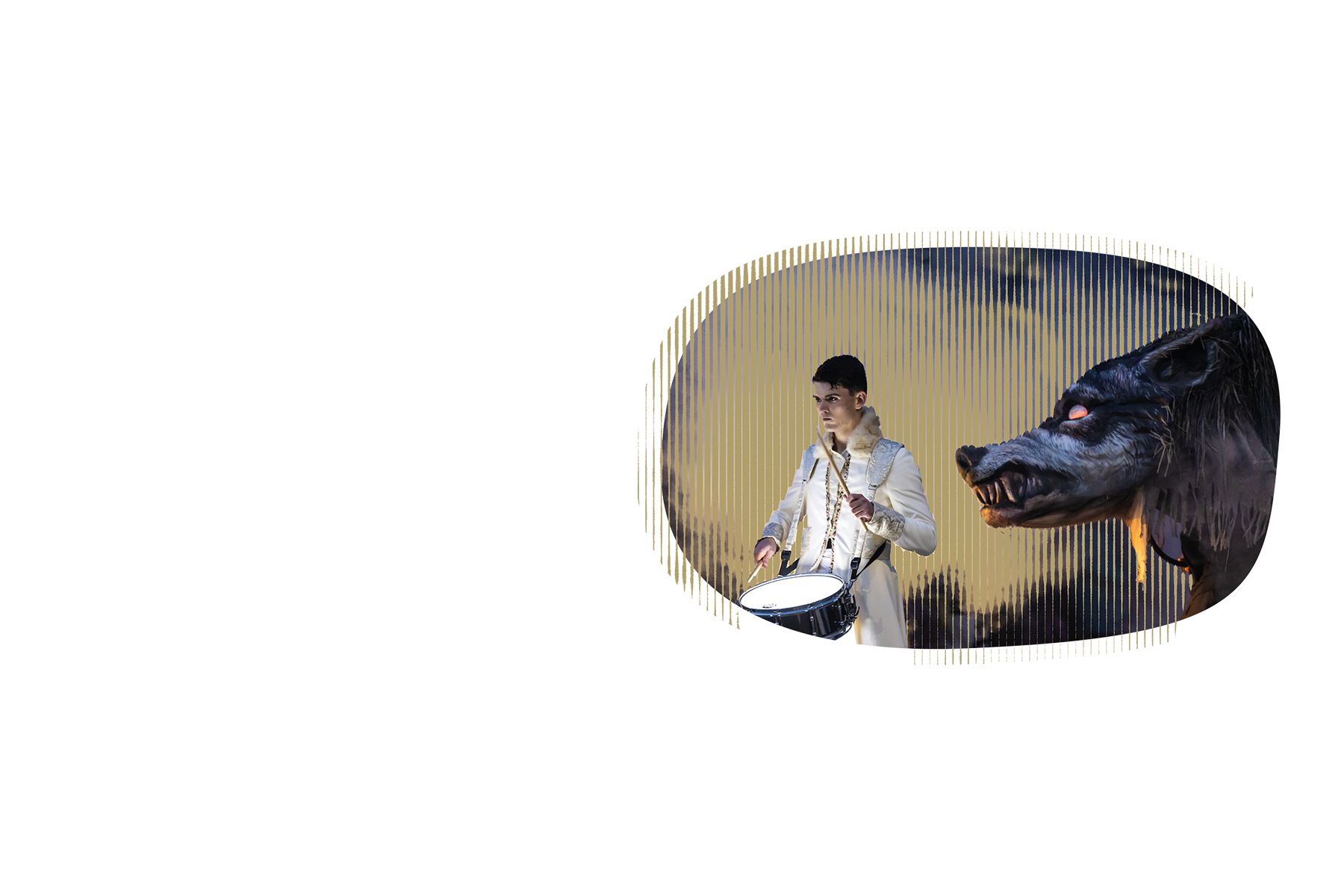
EXPO THEME WEEKS
●
テーマウィーク
Ireland will participate in a substantial manner in all eight Expo 2025 theme weeks, with contributions that deal with their specific subject matter and that offer opportunities to present and expand on important aspects of our theme, Creativity Connects People. For each theme week, we will coordinate significant contributions from the Higher Education and Research sectors, our National Cultural Institutions, Government Departments and State Agencies, and other policy experts.
The Expo Theme Weeks will provide opportunities to highlight an emergent sensibility in Ireland around creativity as a force for good, supported by policy initiatives that promote wellbeing and health, creativity in education and learning, cultural literacy, and new, imaginative ways of addressing conflict and change. The following pages are illustrative of possible approaches to the individual theme weeks.
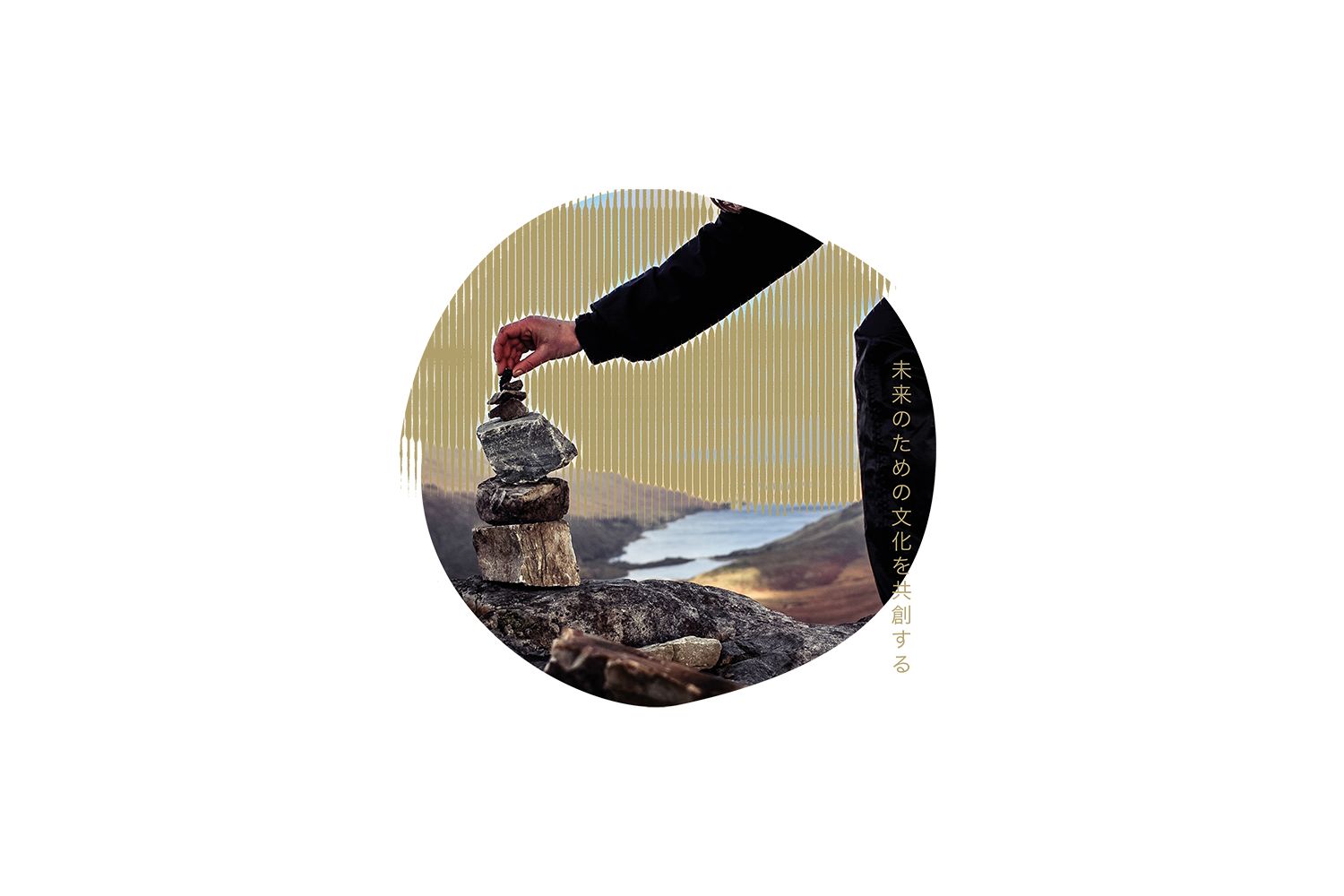
WEEK 1
25 April – 6 May 2025
Co-creating Cultures for the Future
●
For diverse cultures to resonate and co-create cultures for the Future, what do we do
Reflecting our location in the Empowerment District of Expo, Ireland may focus on specific research work that looks at empowering individuals and communities to become aware of, explore and enact possibilities that contribute to the common good through three dimensions: education, research, and community engagement, with the motto, co-create locally, innovate nationally, imagine globally.
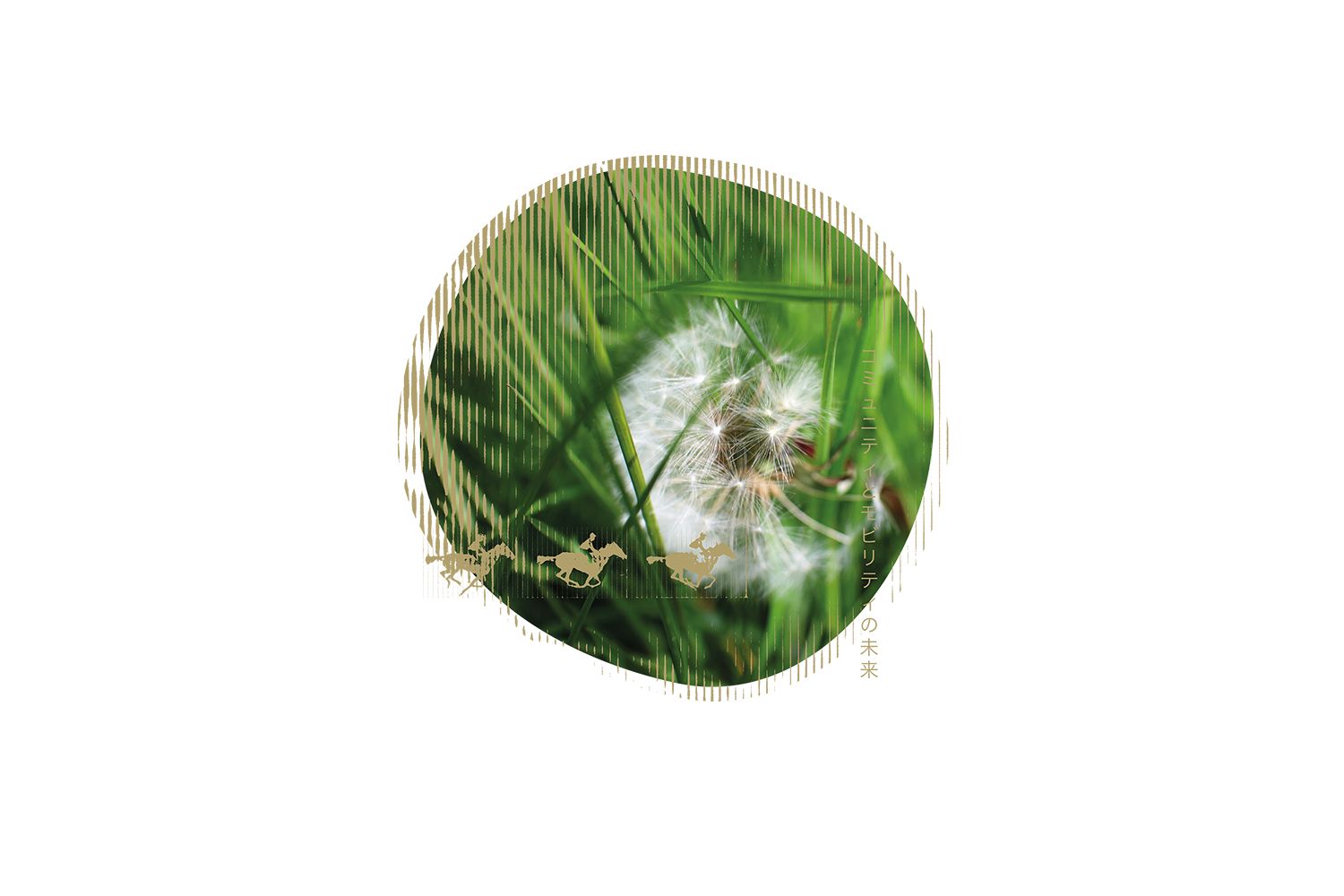
WEEK 2
15 – 26 May 2025
The Future of Community and Mobility
●
What is a community where we can live as we are?
We will place a focus on the Creative Communities pillar of the Creative Ireland Programme which demonstrates the creative potential of our communities. Culture & Creativity Teams around Ireland bring together local expertise in arts, heritage, libraries, enterprise and community engagement, to foster collaboration and spark new initiatives designed to enable people to transform their communities, their lives and their environment through creativity.

WEEK 3
5 – 16 June 2025
Necessities of Life: Food, Clothing and Shelter
●
What do we need to do to realise a future where everyone has access to food, clothing and shelter?
A focus may be Development Aid centred on the work and development-led approach of Irish Aid alongside other Irish world-leading NGOs, and engagement by the Department of Agriculture, Food and the Marine, with international development and humanitarian relief through the UN’s World Food Programme.
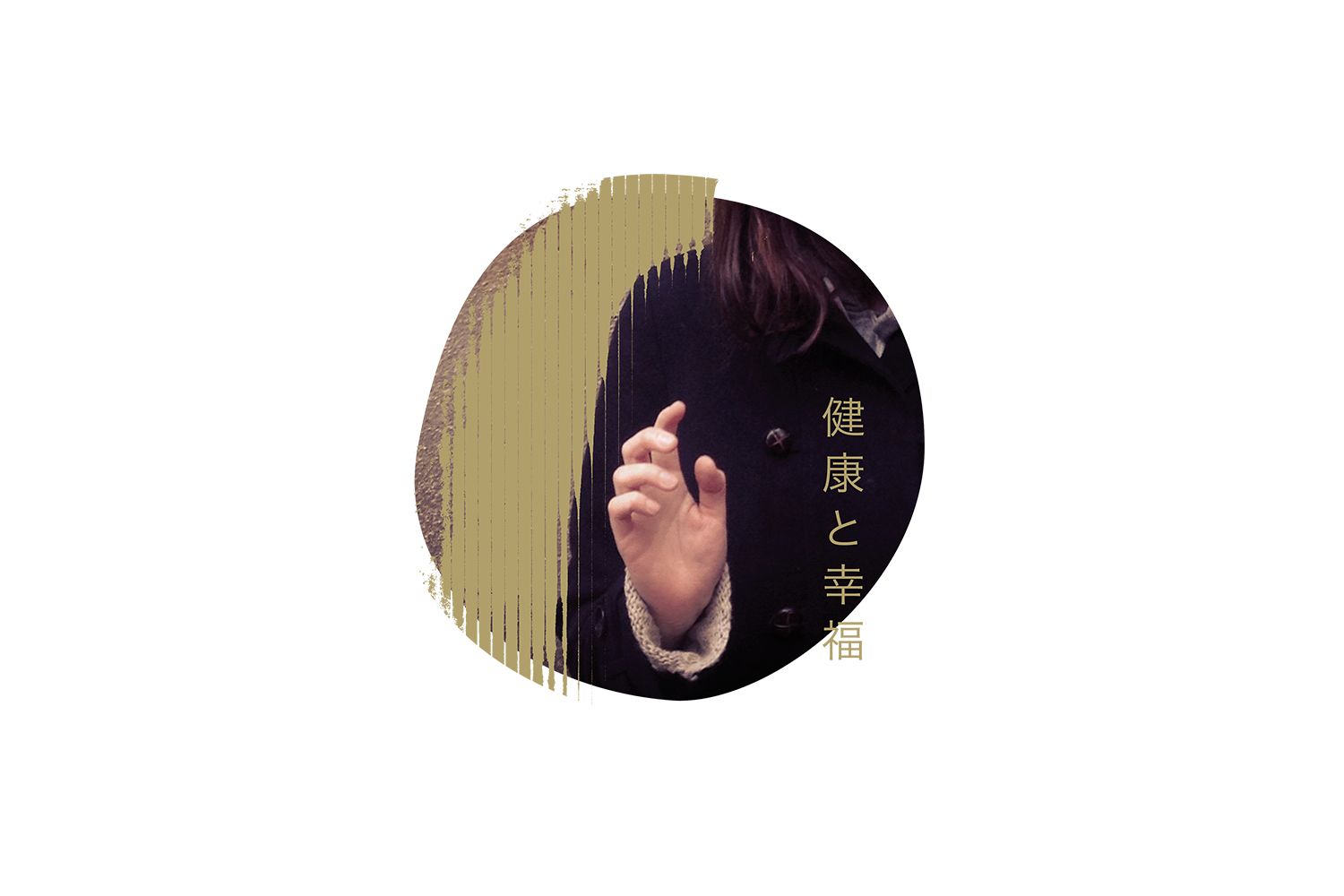
WEEK 4
20 June – 1 July 2025
Health and Wellbeing
●
How do we realise a society where the health and wellbeing of each person resonates?
The expertise and experience of academia, Creative Ireland and Healthy Ireland alongside specific wellbeing projects for young and old may be combined with specific practice-based initiatives around creativity for brain health and arts in healthcare, to demonstrate the increasingly accepted links between creativity and health, with Ireland’s pre-eminence in the Med Tech and Life Sciences sectors forming a central element.

WEEK 5
17 – 28 July 2025
Learning and Playing
●
What should humans learn in the era of AI?
An area of focus may be the Creative Schools Programme, run by the Arts Council. The programme gives our children and young people enhanced opportunities to experience creativity as an integral part of their education, placing the arts and creativity at the centre of school life. It redefines education for the era of AI when the uniquely human capacity for creativity will be critical both for competitive advantage and for human fulfilment. The programme enables young people to learn to communicate, collaborate, stimulate their imaginations, to be inventive, and to understand and harness their curiosity.

WEEK 6
1 – 12 August 2025
Peace, Human Security and Dignity
●
What do we need to do to realise a world where discrimination is eliminated, and people respect each other?
This theme week speaks to the core of our theme for Osaka. The focus on ‘futures’ reflects unprecedented levels of volatility, uncertainty, complexity and ambiguity, characterised by heightened anxiety, depression, and despair about what lies ahead – a sense that the future is something that will be imposed rather than actively imagined and chosen. In this fatalistic environment, a call for widespread, imaginative and creative engagement with the possible is now considered to be vitally important to the wellbeing of individuals, communities and entire societies.
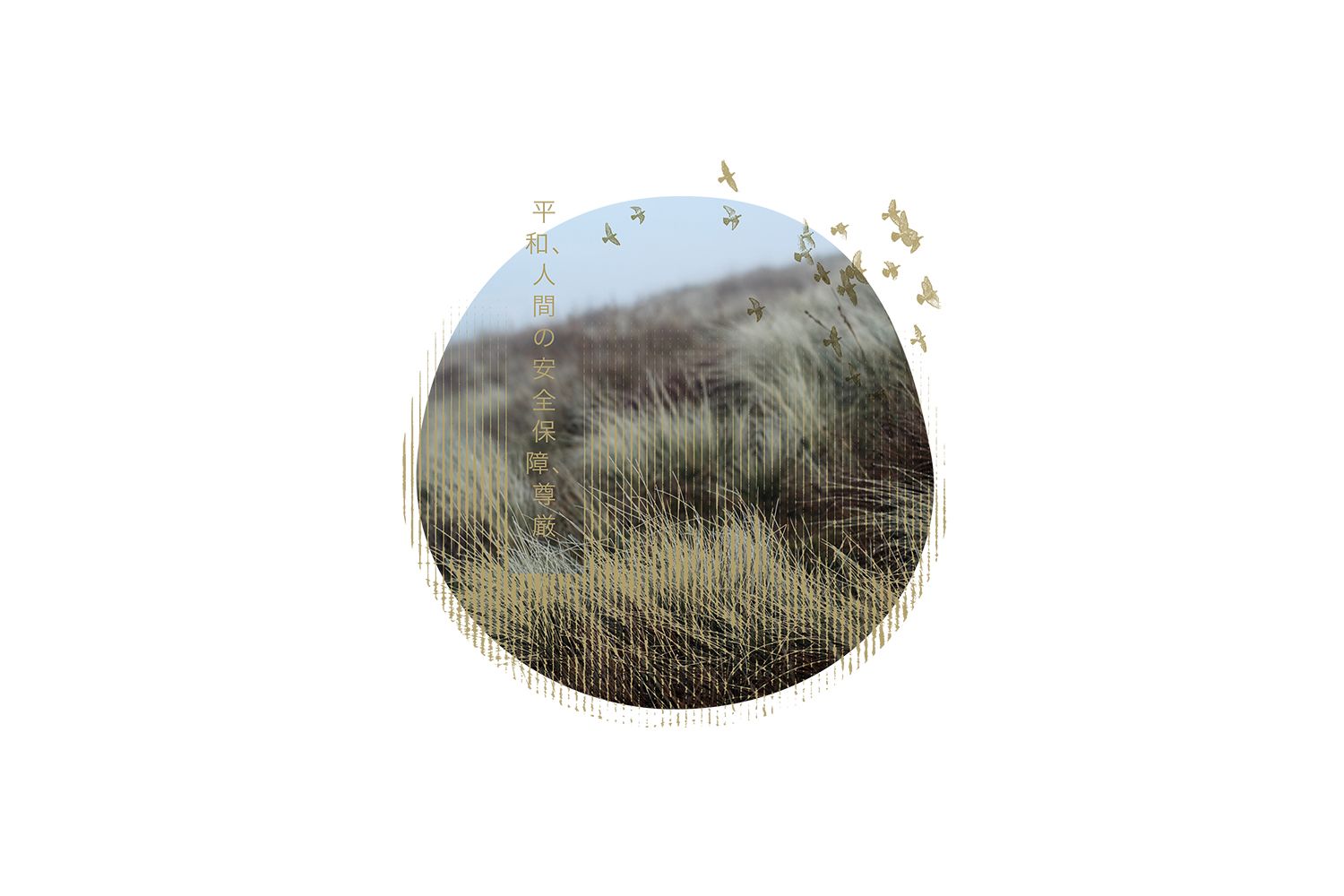
WEEK 7
17 – 28 September 2025
The Future of Earth and Biodiversity
●
What do we need to do to preserve the earth for future generations with abundant and diverse life?
Projects supported by The Creative Ireland Climate Action initiative offer both exhibition and discussion forum potential. The projects pair creative minds with experts in climate science, sustainability and biodiversity, with the aim of connecting the public to the profound changes that are happening in our environment, society and economy arising from climate change, and establishing the connection between behavioural change, climate action and biodiversity.
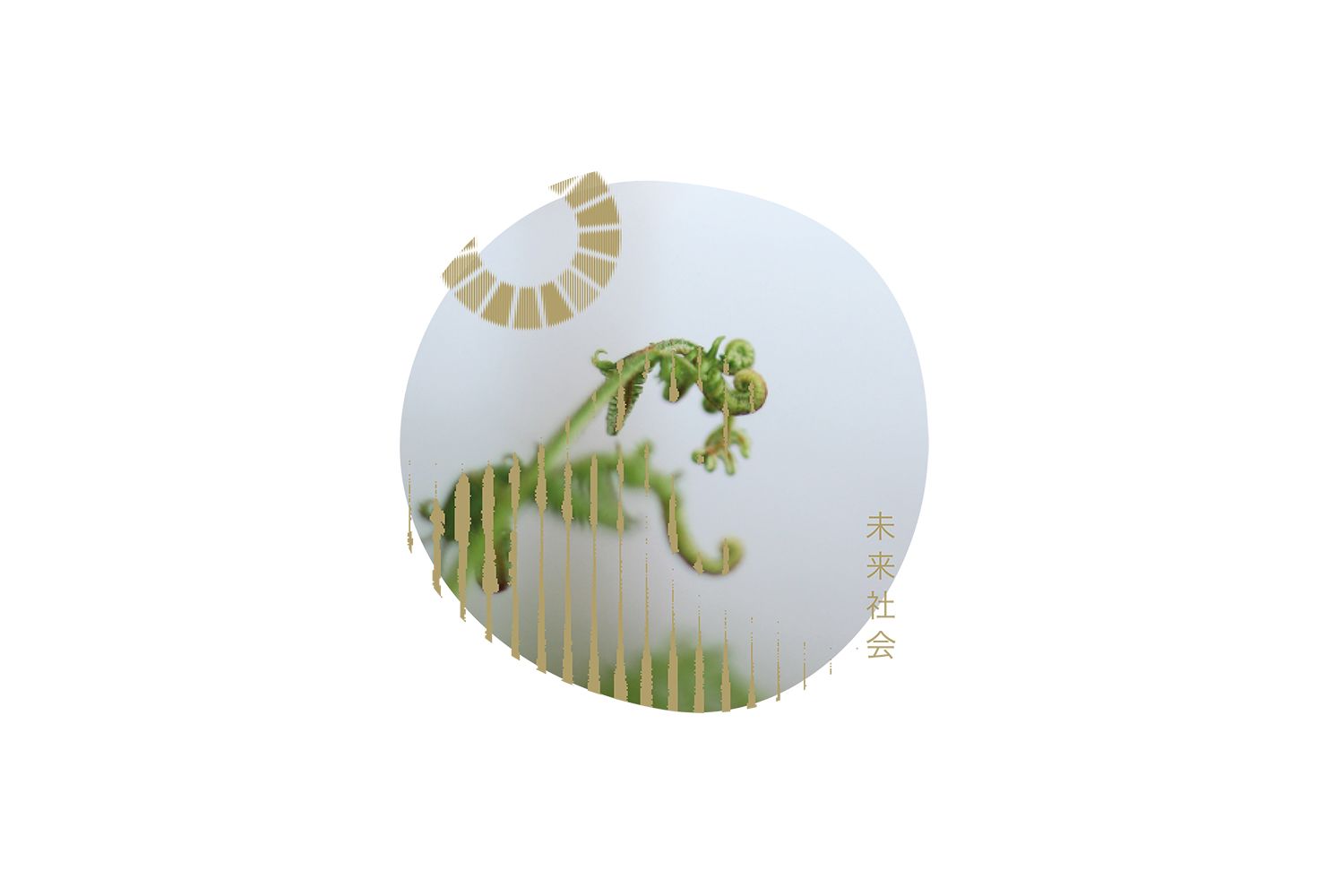
WEEK 8
2 – 12 October 2025
SDGs & Beyond: Future Society for Life
●
Can we achieve the SDGs? What do we do beyond the Goals?
In 2015, Ireland and Kenya were tasked by the UN Secretary General to bring the world together to agree a plan to tackle global challenges by 2030 – which became the Strategic Development Goals. At the UN General Assembly in 2023, Ireland, alongside Qatar, was given the role of securing a political declaration to chart a path towards achieving the SDGs by 2030. For this final theme week, Ireland will create a forum to discuss progress on the Goals, examine impediments and opportunities, and bring a creative, imaginative approach to developing new solutions – and contribute to the debate around extending the goals to include creative and cultural expression.
Team Ireland
Expo 2025 is an All of Government initiative, co-ordinated by the Department of Foreign Affairs, as part of the Global Ireland strategy, incorporating contributions from across Government Departments and State Agencies.
Programme partners include:
Bord Bía
Coillte
Creative Ireland
Culture Ireland
Design & Crafts Council Ireland
Dublin City Council
Enterprise Ireland
Embassy of Ireland Tokyo
Fáilte Ireland
Healthy Ireland
IDA Ireland
Irish Aid
Literature Ireland
The National Concert Hall
The National Museum of Ireland
The Office of Public Works
The Arts Council
Screen Ireland
Tourism Ireland
